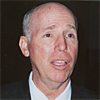Allow Reforms in the Church, or Be Labeled an Accomplice to Sexual Abuse
How Some Pressure Groups Are Fomenting Revolution Inside the Church
On June 1, the American Society for the Defense of Tradition, Family and Property (TFP) sent a letter to the nation’s bishops expressing concern about the Boston-based Voice of the Faithful (VOTF), a movement that sprouted up in the midst of the present Church scandals calling for reform of Church structures. The group’s recent national convention reveals that those concerns were well founded.

On July 20, over 4,000 people gathered at the Hynes Convention Center in Boston for the first national convention of Voice of the Faithful (VOTF), a movement born in the wake of the recent exposure of sexual abuses in the Church.
The one-day event was marked by two high-impact climaxes. The first was a medley of “testimonies” by alleged1 victims and the second was a speech by Fr. Thomas Doyle, a Dominican priest who received VOTF’s first “Priest of Integrity Award.”
An Atmosphere of Intense Emotion
Participants heard these “testimonies” of the alleged victims of sexual abuse both at the beginning and end of the convention. The first round of this contributed greatly toward creating an atmosphere of intense emotion that became the basis for later revolutionary tirades.
Eric Convey and Robin Washington of the Boston Sunday Herald noted: “Several participants in the sessions said that as compelling as the polished academic speakers were, the words of victims were in some ways more significant.” They quoted attendees: “Edward Lotkowski of West Chester, Penn., said he recently heard a victim speak for the first time and ‘it changed me.’” Another participant, Louise Martin of Coventry, R.I., was also shaken: “I felt very, very sad, we really need to educate people to speak up to prevent this very hurtful experience.”2 “Several participants were observed crying at the presentation,” the report continued. “Jana Jones of Santa Rosa, Calif., said the gathering was the first time she had heard the stories of alleged victims firsthand. ‘It’s very moving listening to them. It’s very disturbing.’”3
Personal Drama Becomes Ideological Pressure
There is no doubt that any innocent victim of sexual abuse (not only by members of the clergy) deserves all sympathy and support, and we should do anything within our reach to lessen their suffering and remedy their trauma.
However, using this sympathy for ideological purposes and exploiting personal tragedy as a means of exerting moral and psychological pressure with the intent of making revolutionary changes in the Church is something totally different.
Unfortunately, this seems to be the course taken by the victims’ movements represented at the VOTF convention. Among them, we can mention the Survivors Network of those Abused by Priests (SNAP), the Coalition of Catholics and Survivors, and Linkup.
The fact that these movements appear to be connected to Catholic reform groups that want revolutionary changes in the Church raises doubts about their true objectives.
Lee White, Virginia director of SNAP, for example, declared: “There’s a struggle over power going on. Lay people are asking for more of a voice in the Church, and bishops are digging in their heels. They see lay people as a threat to their authority and power.”4
This is an ideological statement with all the flavor of Marxist class struggle. It criticizes the very nature of the Church’s structure and involves very grave theological questions. Mr. White takes up the position defended by Voice of the Faithful, as we will see below, that the cause of sexual abuse is the hierarchical structure of the Church.
SNAP’s official web site, in its Helpful Links from SNAP section, sends one to Rent-A-Priest,5 an association of married priests. For obvious reasons, this association advocates not only the end of priestly celibacy but also women priests and the remarriage of divorced people. It also promotes democracy in the Church.6
It becomes quite clear that SNAP (and other organizations) base their action on an ideology like that of revolutionary Catholic movements that want to democratize the Church, going headlong against the will of Our Lord, Who established the Church as a monarchy in the person of Saint Peter and the Apostles and their successors, the Popes and the bishops.7
Abusive Generalizations Create Emotional Impact
Susan Renehan, from the Coalition of Catholics and Survivors, recounted how she was abused by a priest and left the Church as a consequence. Her assessment was brutal: “Priests are raping and abusing your children and your bishops are hiding it.”8
The use of such abusive generalizations is a technique that creates emotional impact. It suggests that, while Catholics are sitting at that meeting, priests are attacking all our children, and all bishops are hiding it. The statement creates a feeling of urgency, calling for quick and energetic action to protect all children. The action suggested throughout the Voice of the Faithful convention was “reform the Church’s structure” by transferring power to the faithful.
In the same rude tone, Renehan presented the alleged victims as a new Magisterium of the Church: “You need our voice to teach you that you need to heal before you can forgive, and you need the truth before you can heal.”9
Using “Talismanic” Words
Throughout the event, the alleged victims were also referred to as survivors, without any explanation as to what this new class of people signifies. Survivors in relation to whom or what? It is, of course, a metaphorical use of the word.
Having suffered sexual abuse is undoubtedly a traumatic experience, but it is an exaggeration to compare it with somebody who suffered immediate and serious risk of life, as in an accident or catastrophe in which others perished, as the current use of the word suggests: “Send help to the survivors of the earthquake.”10
In this case, the use of the metaphor becomes a means of exerting psychological and emotional pressure. Survivor becomes a “talismanic” word, aimed at causing an ideological transshipment of the public.11
The word survivor is used in a subtle and emotionally charged way, giving it a new and almost magic power that goes much beyond its semantic value. It confers a kind of new ontological quality upon the person to whom it refers and puts him above those who did not participate in his experience. Being a survivor becomes like a new “sacrament,” which gives him an authority to pronounce himself in an uncontestable way.
Telltale in this regard is a picture of a Boston protest on the Call to Action website. One sign that appears in the picture reads: “The Victim is the Authority.”12
A Strange “Survivor”
At the convention, Mary Scanlon Calcaterra presented survivor Arthur Austin as “a prophet.”13 The story of this survivor is strange, to say the least.
Writing about the Father Shanley story, reporter Sacha Pfeiffer followed the case of 53-year-old Arthur Austin, who has a claim pending against Fr. Shanley. He reports that “he went to the priest for counseling after his first gay relationship ended when he was 20. He was given ‘access’ to Shanley’s body to ease the pain of the breakup, Austin said Shanley told him.”14
Chuck Colbert in The National Catholic Reporter confirmed that “two men, Arthur Austin of Braintree, Mass., and John Harris of Norwood, Mass., both of whom have accused Shanley of sexual abuse, are openly gay. During an interview, Austin said that as a young man of 20 he was facing a difficult time after the breakup of a same-sex relationship when Shanley took advantage of him.”15
The same Mr. Colbert reported on a march promoted by the Coalition of Catholics and Survivors. Ms. Renehan gave a speech during the march. Mr. Colbert writes: “Lesbian and gay Catholics, along with more than 20 members of Dignity/Boston, the region’s leading gay Catholic faith community, took part in this past weekend’s solidarity walk and survivors’ storytelling event. The solidarity walk was sponsored by the Coalition of Catholics and Survivors (CCS), one of two major church-reform and advocacy organizations that have sprung to life in the wake of the Boston archdiocese sex abuse scandal…. Three openly gay men spoke out…. The third openly gay survivor to speak was Art Austin.”16
It is difficult to understand how this “victim” – presented as a “prophet” – can be called a survivor of homosexual abuse when, as a man of twenty, he was himself openly homosexual. This case has nothing in common with the “pedophile cases” so insistently reported by the media.
.jpg)
Father Doyle’s Radical Egalitarianism
The second high-impact climax at the VOTF convention was the inflammatory speech of Fr. Thomas Doyle when accepting the “Priest of Integrity” award. His address succinctly summarized the egalitarian philosophy that inspired the whole convention.
Father Doyle adopted the survivor metaphor by speaking of “the victims turned survivors.” He affirmed that “victims are in truth the most important people in God’s Church.”17
He stated that sexual abuse was only a symptom of “a deeper disease: a deeper and much more pervasive and destructive malady – the fallacy of clericalism.”
Father Doyle said that the first symptom of this disease of clericalism is the false notion that the clergy has a special mission to sanctify the laity and is thus above everybody else and deserves privileges. Amid applause, Father Doyle concluded that the most “deadly symptom of all is the unbridled addiction to power” and urged his audience “to help those addicted to power free themselves from these chains.”
The way to liberate the bishops would be by dismantling the hierarchical Church and implementing democracy. To intense applause from the audience, Father Doyle delivered a completely egalitarian address that echoed the modernist doctrine condemned by Saint Pius X.
Father Doyle affirmed it was “the governmental system that has caused” the sexual abuses, so “we must have a real change.” The abuse by the bishops, he said, is sustained “by the myth that what is good for this small minority, an episcopal leadership, is good for all of us; the myth that the good of the Church is our good.”
This Dominican priest thundered that the bishops have taken away the power of the laity, especially the underprivileged, who actually should be the real authorities: “The most vital members of the Church are not those who wear elaborate robes and sit on the thrones of power, but the marginalized, the hurting, the rejected, the forgotten, and the voiceless. And today we’re taking back what has been hijacked from us.”18
Father Doyle claimed the present crisis marks “the beginning of the death throes of the medieval monarchical model” of the Church. The hierarchical Church was a result of the “misinterpretation of Christ’s gift of the keys to the kingdom to St. Peter.” This erroneous interpretation served “as the rationale for a hierarchical system which was later invested with all the trappings of monarchy.” As a consequence, he continued, we must end all aspects of monarchy within the Church and the false conception that the “Church is a kingdom made up of a string of fiefdoms called dioceses.”
Doing this will allow the Church to return to “Christ’s radical egalitarianism.”
Father Doyle’s (not Christ’s) “radical egalitarianism” led him to invite the audience “to abandon the magical thinking that sustains the medieval paradigm” of the hierarchical Church. This magical thinking was based on the “magical notion of sacraments and magicians as priests and bishops who administer them.”
The defense of egalitarianism in the socio-political order is a philosophical error. In the Church, however, it becomes a theological one. This is because the hierarchical system of the Church is based on the sacrament of Holy Orders.
According to noted theologian Adrien Gréa, “The first foundation, the very core of hierarchical power, is the sacrament of Holy Orders.”19
It is timely to recall that the Council of Trent condemned with anathema those who deny the existence of a hierarchical priesthood or its power to consecrate, as well as those who affirm that “in the Catholic Church a hierarchy has not been instituted by divine ordinance, which consists of the bishops, priests, and ministers.”20

Democratization of the Church
Dr. James Muller, founder and ex-president of Voice of the Faithful, projected slides illustrating his understanding of the crisis in the Church. He concluded that the most profound cause is centralized power with no voice of the faithful. American democracy is his model for the Church.

Prof. Leonard Swidler, another speaker, supports the idea of women priests and democratization of the Church. He has even drafted a “Constitution of the Church” and written a book on the subject. The Church he envisions in his constitution would be governed by a General Council elected by representatives of national Churches. This General Council would be co-chaired by a Pope and a lay person for a non-renewable ten year term.21 At the convention, Prof. Swidler’s workshop, “Guidelines for setting up a parish (diocesan) constitution,” was an application of his revolutionary ideas.

Financial Blackmail
Dr. Muller recommended the use of financial pressure: “No more donations without representation. We have to gain financial power in this Church. They say the laity are weak, but we are 99.9 percent of the Church and 100 percent of the money, and we now have a structure where we can exert that power.”22
The new president of Voice of the Faithful, Dr. James Post, declared that a “hierarchy that failed to protect our children cannot be trusted to exercise sole control over the property, money and fate of our church.” He defended the right of the laity “to participate in the decision-making processes of each parish, each diocese and the whole Catholic Church.”
He defined the terms of the group’s dialogue with the bishops. “Let me be clear about the terms of this dialogue: We will not negotiate our right to exist. We will not negotiate our right to be heard. We will not negotiate our right to free speech as American Catholics.”23
A Time for Woman-priests?
The continuous references to women’s ordination, which were always applauded, and the total equality between laity and clergy gave the VOTF convention another charge of radical egalitarianism.
In a very theatrical manner, Fr. William Kremmell, vested to celebrate Mass, commented amid general enthusiasm that 25 years ago a bishop would have celebrated Mass for such a large gathering. He foresaw that 25 years hence the celebrant would be a “married woman.” “For the moment,” he added jokingly, “you have just me!”24 This provoked general laughter.
Married Priests Mark Meeting
There were several married priests among the speakers at the convention. Either openly or indirectly, they criticized priestly celibacy and advocated women priests.

One of these married priests, Anthony T. Massimini, contended that cultural aspects of Judaism and Christianity were responsible for the idea that there is some sort of curse on women.
In an essay referred to as “The Guide” by VOTF leadership and recommended as must reading for everyone planning on attending the convention, Mr. Massimini states: “Early Christian leaders went so far as to erroneously regard Mary Magdalene, a close friend of Jesus and a highly respected Christian woman, who was a leader in the early church, as a prostitute. The clerical culture picked up this negative mindset.”25 Mr. Massimini based his convention address on this essay.
Mr. Massimini’s call for the abolition of priestly celibacy was not very subtle. He acknowledged there is no direct link between celibacy and pedophilia, but affirmed that only a tiny number of priests have the gift of celibacy and claimed that because Church teaching insists on priestly celibacy, “the psychological and spiritual damage being done to the Church is immense.”26

We Are Church – Germany
Reform Movements Abound
Besides married priests, members of the Women’s Ordination Conference, Call to Action and We are Church movements were also numbered among the speakers. All these groups have long advocated a complete reform of the Church, including women’s priesthood and the end of priestly celibacy.
Andrea Johnson of the Women’s Ordination Conference and Call to Action’s Jan Leary and Linda Pieczynski27 directed workshops.
Dan Daley, co-director and a founder of Call To Action remarked that “many of those at the gathering were members of Call to Action Massachusetts.” He said he had begun conversation with leaders of the new group about possible collaboration in the future.28
We are Church was represented by its international president, Thomas Arens, who came from Germany. In his speech Mr. Arens declared emphatically, “We have to abolish the two-class system in our Church.” Just as the Berlin Wall was torn down, Mr. Arens said, “we have to tear down the wall which separates the clergy from the laity.”29
Sexual Liberation Movements Are Present
Pictures taken at the event show at least one of the participants wearing a T-shirt with a Dignity/Boston logo. It is well known that this homosexual group does not reflect Catholic teaching.
Speaking on “What parishioners and parents can do to create a sexually safe parish” was none other than Debra Haffner, a non-Catholic sexologist notorious for her positions at odds with the traditional teaching of the Church.
Haffner is a former president of the ultra-liberal Sexuality Information and Education Council of the United States (SIECUS), which advocates same-sex marriage and gay-lesbian religious ministers.30
Another speaker at the convention was Michelle Dillon, author of Debating Divorce: Moral Conflict in Ireland, Gay and Lesbian Catholics, and Catholic Identity: Balancing Reason, Faith, and Power. Her books all reflect a liberal and reformist perspective.31
A New Liberation Theology?
With these details from the Voice of the Faithful Convention, one can conclude that certain priests and laity desire to start (or continue) an egalitarian revolution in the Church similar to the French Revolution, where power was transferred from the king to the people. Another comparison might be the Bolshevik Revolution in Russia, where Lenin’s slogan “all power to the soviets,” would become “all church power to the laity.”
In Latin America, proponents of liberation theology used the poor (dubbed the “oppressed”) as a pretext for a class struggle that would liberate them from oppressive structures, meaning the capitalist system. The proposed solution was the Marxist classless society.
In the United States, a new class struggle is being created. The new “oppressed” class consists of the victims of sexual abuse. The new “oppressors” are clergymen and the hierarchical structure of the Church. The proposed solution is an end to this clerical oppression by establishing a classless society in the Church.
Liberation Theology in Latin America adopted the Marxist myth of turning the proletariat into a redeemer. Because it is exploited, the oppressed proletariat does not participate in the sins of the oppressors. Therefore, when the proletariat liberates itself from oppression, it also liberates the very oppressors from the chains of the structures of oppression. This same mythology is being applied to the present scandals. The victim of sexual abuse, the “survivor,” does not participate in the vices of the oppressive clerical system. He is thus qualified to be the “redeemer” so that when the victim “liberates” himself, he liberates his oppressors by destroying the structures of oppression, that is, the Church’s hierarchical structure.
Rejecting a False Dilemna
There is a climate of intense moral and psychological pressure surrounding the sexual abuse scandals.
The faithful are called to choose between two false options: Either support unconditionally the reforms in the Church proposed by pressure groups supposedly speaking in the name of the victims, or be labeled accomplices with those priests who engaged in criminal behavior and those bishops whose actions or omissions allowed the crimes to continue unpunished for so long.
This is a false dilemma.
The faithful, clergy and laity alike, must reject both the proposed reforms and the label of complicity.
We can both empathize with the unfortunate victims and vent indignation toward the perpetrators while faithfully defending the hierarchical structure of the Church as instituted by Our Lord.
Moreover, this fidelity does not prevent us from respectfully asking that appropriate measures be taken against these abuses. These measures must be taken in accordance with Church teaching.
An Institution at Risk
The present juncture of events calls to mind an historical fact. After the storm of the French Revolution and Napoleonic Wars (1789-1814), monarchy was restored in France. The king, Louis XVIII, was legitimate but liberal. The anti-liberal monarchists founded a newspaper called Le Drapeau Blanc (The White Flag). Their clear-sighted understanding of the problem and staunch fidelity to principle led them to proclaim: “Vive le Roi!… quand-même” – Long live the king, despite everything.
The meaning of the motto was that the institution of the monarchy was much more important than the actual king. To the measure that the king, although liberal, represented monarchy, he should be respected.
This can be applied today to the episcopal office, especially when revolutionaries use the very real faults and complicity of many bishops as a tool to destroy the hierarchical institution founded by Our Lord Jesus Christ Himself.
Updated September 7, 2018
___________________
Footnotes
1. We employ the word “alleged” in the same way many newspapers are doing, without any derogatory intent pending independent verification.
2. Eric Convey and Robin Washington, “Laity Gets Tough on Law,” Boston Sunday Herald, 7/21/02, p. 5.
3. Robin Washington, “Advocates Ask Flock to Show Their Anger”, ibid.
4. Susan Hogan Albach, “Some Bishops Leery of Sharing Authority,” The Dallas Morning News, 6/16/02.
5. http://www.peak.org/~snapper/Helpful_Links/Helpful_Links_Page.htm.
6. Cf. http://rentapriest.com, home page and especially the article “39 Popes Were Married,” by married priest John Shuster, who defends the end of priestly celibacy and the ordination of women. See also The Church IS a Democracy, by Daniel C. Maguire which, as the title of the article already implies, denies the Church is a hierarchical society.
7. Cf. Cardinal Charles Journet, The Church of the Word Incarnate, (New York: Sheed & Ward, 1954), vol. 1, pp. 422-423.
8. Eric Convey and Robin Washington, “Laity Gets Tough on Law,” Boston Sunday Herald, 7/21/02, p. 5. Cf. Resurrection Tapes, Voice of the Faithful National Conference, Tape 02VF1.
9. Chuck Colbert, “4,000 Meet to Give Laity a Voice,” The National Catholic Reporter,” 8/2/02. Cf. Resurrection Tapes, ibid.
10. On the SNAP site, David Clohessy tries to justify the use of this expression, saying that some abused persons committed suicide. Cf. SNAP BASICS Q & A with David Clohessy, http://www.survivorsnetwork.org. In this case, all abused victims who did not commit suicide would be “survivors.” This is stretching the metaphor too far. By the same logic, the many who suffer from broken relationships and do not commit suicide can be called “survivors” since it is well known that some people commit suicide because of broken relationships. It is absurd to call someone a survivor in order to invest him with an authority that common people do not have.
11. Cf. Plinio Corrêa de Oliveira, Unperceived Ideological Transshipment and Dialogue, Chapter 3 – “The Talismanic Words, a Stratagem of Unperceived Ideological Transshipment.”
This opportune study shows how words can change thinking. (This is especially true when telecommunication and the Internet make the manipulated word ever more powerful.)
The careful crafting and spinning of a single word or expression carries a world of ambiguous meanings that gradually shapes the thinking and mentality of the unwary victim.
Words like tolerance, empowerment, and diversity are part of a politically-correct lexicon that proposes a whole agenda that includes abortion and homosexual “marriage.”
Prof. Plinio Corrêa de Oliveira makes a case study of the word dialogue and its use to dissolve differences between opposing sides of an ideological debate. To understand the profound process behind the use of what the Brazilian scholar calls “talismanic” words, Unperceived Ideological Transshipment and Dialogue is an invaluable work that will give the reader the insight needed to oppose the often imperceptible use of words to change thinking.
12. The photograph’s caption reads: “Groups like Coalition of Concerned Catholics (pictured) and Voice of the Faithful in Boston are leading a revolution by lay people to take back the Church after failures of leadership by cardinals and bishops.” Cf. www.cta-usa.org/watch05-02/watch05-02.html
13. Eric Convey and Robin Washington, ibid.
14. “Famed ‘Street Priest’ Preyed Upon Boys,” The Boston Globe, 1/31/02.
15. Chuck Colbert, “Documents Provoke Fresh Anger,” The National Catholic Reporter, 4/19/02.
16. “Victims of church abuse scandal take to the streets. Three gay survivors of priest sex abuse speak out at solidarity march,” innewsweekly.com, 6/4/02.
17. Cf. Resurrection Tapes, Voice of the Faithful, tape 02VF2. (All quotations from Fr. Doyle are taken directly from the recording purchased at the VOTF event).
18. Such statements are similar to concepts found in liberation theology, where the oppressed and the marginalized are considered the real messiahs and redeemers of mankind.
19. D. A. Gréa, De L’ Église et de Sa Divine Constitution (Brussels-Geneva: Société Génerale de Librarie Catholique, 1885), p.100.
20. Denzinger, 966.
21. Cf. Toward a Catholic Constitution (New York: Crossroads Publishing Company, 1996). Also cf. http://arcc-catholic-rights.org/constitution.htm.
22. “Voice of the Faithful Vows Reform,” Boston Sunday Globe, 7/21/02.
23. Chuck Colbert, “4,000 Meet to Give Laity a Voice,” The National Catholic Reporter, 8/2/02.
24. “Voice of the Faithful Vows Reform,” Boston Sunday Globe, 7/21/02.
25. Cf. http://www.votf.org/papers/TheGuide.html
26. Ibid.
27. A Call to Action press release of March 8, 2002 reads: “‘The Vatican is trying to deflect attention from the role of the U.S. bishops who created this current clergy sex abuse crisis. It has nothing to do with gay priests,’ said Linda Pieczynski, spokesperson for Call to Action.” See http://www.cta-usa.org/press/gaypriests.html
28. Chuck Colbert, “4,000 Meet to Give Laity a Voice,” The National Catholic Reporter, 8/2/02.
29. “Voice of the Faithful Vows Reform,” The Boston Sunday Globe, 7/21/02.
30. “Defying conservative sentiment, some 850 religious leaders are embracing a declaration that all faiths should bless same-sex couples and allow gay and lesbian ministers. It is sponsored by the Sexuality Information and Education Council of the United States, or SIECUS. ‘For too long, the only voices in the public square on religion and sexuality have been the anti-sexuality pronouncements of the religious right,’ SIECUS head Debra Haffner told the Associated Press.” (http://www.tennessean.com/sii/00/02/20/bishopbar20.shtml)
31. Ms. Dillon explains her thinking: “In my recently published book (Catholic Identity: Balancing Reason, Faith, and Power [Cambridge Univ. Press, 1999]), I take a sociology of culture approach to the production of Catholicism. Focusing on institutionally marginalized Catholics (gays/lesbians, feminist and pro-choice Catholics), I show that contrary to a hierarchical, top-down model of religious production, these Catholics are active interpreters, and thus relatively autonomous producers of Catholic doctrine.” (Cf. http://www.people.virginia.edu/~bb3v/symbound/forum/
forum8/vforum4.html.

